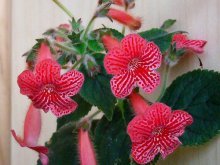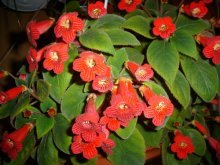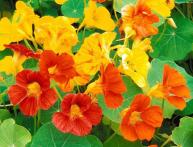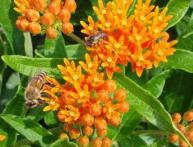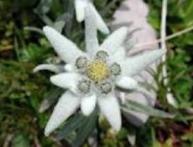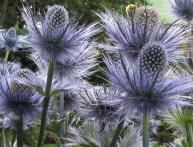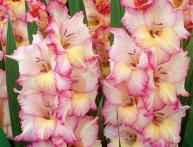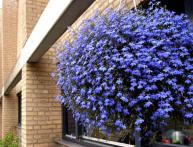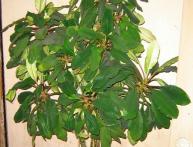The Kaleria flower is a bright representative of the Gesneriaceae family.
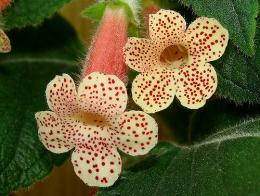
Kaleria is a very beautiful plant, which is not yet very common among amateur gardeners. Kaleria has a very beautiful exotic color and is easy to care for.
Content:
Description of the plant
This plant is a member of the Gesneriaceae family, and grows in tropical areas of America. More than 65 species of plants of this family include the genus Kaleria, and grow in Central America, Mexico, and Colombia.
Kaleria leaves are up to 8 cm wide and up to 15 cm long, have a fleecy surface, the edges of the leaves are crenate, and the shape is ovate-oblong. The color of the leaves depends on the type of plant: dark green with red veins, olive, having a light central vein. The hair on the leaves is either red or white. Among the hybrids there are bronze and silver leaf colors.
Kaleria is very different abundant flowering. The number of flowers on a peduncle varies from one to three. Kaleria flowers have the appearance of bell-shaped corollas, with a tube tapering towards the throat. Sometimes the flowers are shaped like thimbles. The throat of the flowers has five rounded petals, which are covered with specks and strokes.In nature, Kaleria flowers have a variety of colors: pink flowers with a white throat, covered with dark pink specks; red-orange with a yellow throat and red streaks; brown with white throat and white specks, etc.
As a result of crossing different species, the color of Kaleria flowers can acquire cherry, golden, amethyst, fuchsia shades, and even a “tiger” color is found.
Kaleria is well suited for ordinary apartments, since this plant is less demanding in terms of living conditions.
Varieties of Kaleria
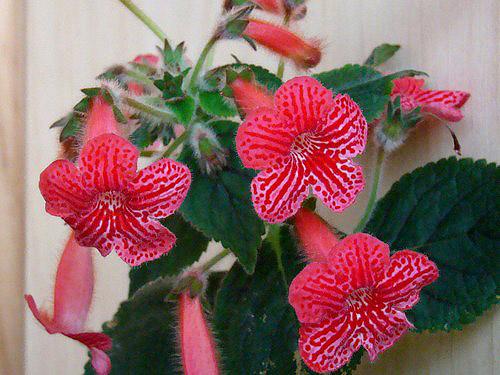
- Fluffy-flowered Kaleria. This species has leaves of a rich dark green color, with reddish hair along the edge. The bright orange flowers of Fuzzy Caleria have yellow dots on the petals and reach 5 cm in length. The plant is quite large, aboveground shoots are up to 80 cm long.
- Foxglove Kaleria. The size of this plant species is similar to the size of the Fuzzy Caleria. The opposite leaves are ovate-oblong in shape, light green in color and quite large in size - 15 cm long and 8 cm wide.
- Nice gallery. Characterized by lower growth compared to the previous species. The wide, ovate leaves are silver-green in color with brown-purple veins. The flowers of Calleria pleasanta have small size - only 2 cm. The color of the flowers is bright pink, there are crimson specks on the bend of the petals.
Growing Kaleria. Peculiarities
- Air humidity. Kaleria is tolerant of dry air, but still gives greater preference to humid air. But it should be remembered that the fleecy leaves of the plant do not like direct contact with water drops.In this regard, to create humidity, it is necessary to humidify the air around the plant using a sprayer, without directing a cloud of water at it. Also, a pot of caleria can be placed in a container with damp expanded clay or moss. Warm soft water is best for watering and spraying.
- Watering. Kaleria needs water moderately, I do not allow the soil to become waterlogged. However, you should not overdry the soil. When the plant does not bloom - during winter - watering should be reduced.
- Lighting. This plant loves light, so Kaleria needs a well-lit place indoors. In summer, you should make sure that the place for the plant is not too hot and is protected from direct sunlight. The best place for Kaleria will be a windowsill, because it is a tropical plant that loves light and will be drawn to it. Otherwise, the plant will be distorted, which will disrupt its decorative function.
- Temperature conditions. For Kaleria, moderate air temperatures are suitable, up to 25 degrees Celsius. During rest, when the plant does not bloom, it is better to reduce the temperature to 17 degrees. You should pay attention to the fact that Kaleria is afraid of drafts.
- Diseases. The Kaleria flower is not susceptible to diseases and pest attacks. Spider mites or aphids rarely appear on leaves. Rot may also appear due to excess moisture in the soil. When drops of water fall on the delicate leaves of a plant, spots appear, the leaves dry out and fall off.
Kaleria reproduce best in the spring, but it is also possible at other times of the year. Methods of propagation of Kaleria: division of rhizomes, seeds, rooting of cuttings.
During flowering, the plant is fertilized with special fertilizers for flowering indoor plants.There is no need to fertilize the plant during the dormant period.
Plant care
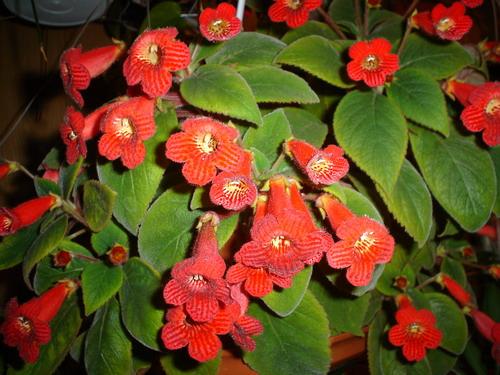
Kaleria blooms in autumn and summer, the rest of the time the plant rests. In summer, the plant needs good lighting and regular feeding. The air should be well humidified, and the temperature should not exceed 25 degrees. But do not forget that when exposed to direct sunlight, burns appear on the leaves of the plant.
In the autumn, when flowering stops, watering the plant should be reduced.
With the beginning of the dormant period, that is, in winter, the plant, or rather its above-ground part, dies. Kaleria rhizomes are left in the ground and transferred to a cool, dry room where the air temperature is about 13 degrees Celsius. In the spring, you can start breeding Kaleria.
It is advisable to replant the caleria every spring. A low, wide pot is suitable for this plant. It is worth paying special attention to the soil; the most suitable mixture for caleria will be: humus - half a part, leaf soil - 2 parts, peat - 1 part, sand - 1 part. It is possible to add phosphorus fertilizer.
As you can see, indoor flower Kaleria is a godsend for amateur gardeners, as it does not require special care and growing conditions, and also has various variations in design. If you give this beautiful plant the right care, you can enjoy its magnificent blooms all year round.
How to propagate Kaleria leaf, watch the video:
Interesting information about the vegetable garden

